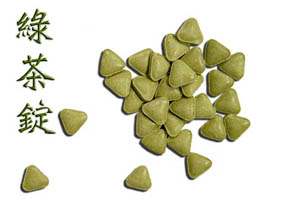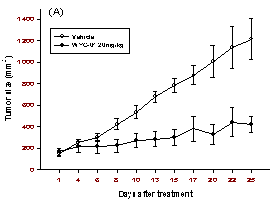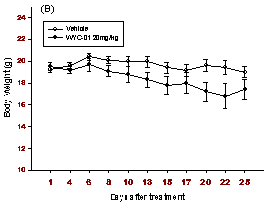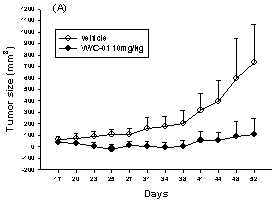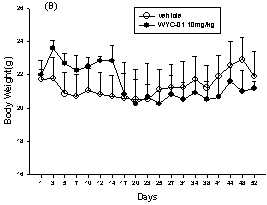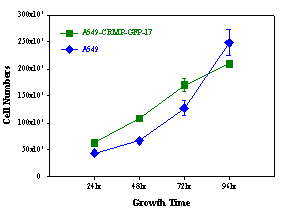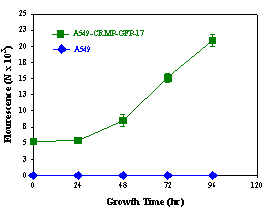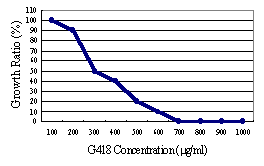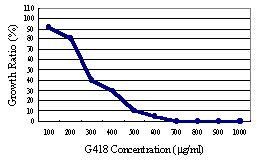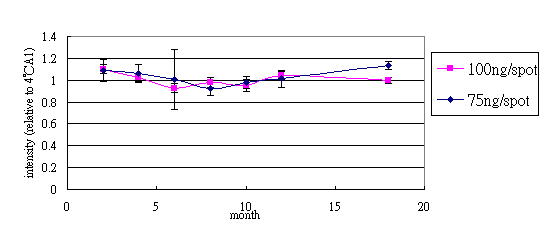|
||||||||||||||||||||||||||||||||||||||||||||||||||||||||||||||||||||||||
|
WYC-01
抗癌活性之簡介 怡發科技研究團隊結合學術界研究天然物及抗癌生物活性之專業人才,成功開發來自天然物的抗癌藥物-WYC-01,研發成果簡介如下。 1.
WYC-01 來源之優勢:(1)屬於台灣產植物。(2)已有成熟的種植經驗。 2.
WYC-01 發展優勢 (1)
已經具備符合美國FDA 之CMC 產程經驗,具5~10%
的產率。 (2)
WYC-01
以口服方式進行治療,可以提高癌症病人的生活品質,居家照顧。 3.
WYC-01 抗癌功效
(1)
體外抗癌活性測試結果:對人類肺癌、直腸癌、卵巢癌乳癌及攝護腺癌細胞株有很好的毒殺效果,IC50
呈現 ”<4mg/ml” 的優勢。對乳癌細胞株MCF-7,IC50 為
“<0.01mg/ml”,有最好的毒殺效果。 (2)
體外抗癌活性測試結果:對具抗藥性人類肺癌細胞株有高敏感的選擇性毒殺現象,和已知抗癌藥物Taxol相比,IC50有25
倍優勢差異。 (3)
體外抗血管新生測試結果:在tube formation assay
方面,具有70% 的抑制比率。 (4)
體內安全性測試:三種劑量15, 20 and 25mg/kg連續口服投予28天,體重表現正 (5)
體內抗直腸癌活性測試:以20 mg/kg劑量連續口服投予21
天,呈現很好的抑制腫瘤成長的效果。(see figure 1 ) Figure 1
(6)
體內抗藥性肺癌硬塊腫瘤測試結果:以10 mg/kg劑量口服投予共52
天,呈現很好的預防腫瘤復發的效果。(see figure 2)
Figure 2
Contents
Human
lung adenocarcinoma cell A549 was transfected stably with the DNA
construct, EGFP-hcrmp1, containing 1.9 kb of promoter region of CRMP-1
gene and the reporter (GFP) gene.
The promoter fragment was inserted into the multiple cloning
site of pEGFP-1 plasmid (BD Biosciences; Ref. 1). Product
Information
CRMP-1
promoter/GFP Reporter Cells are homogenous and show proportional
increase of fluorescent intensity (Figure 2) during cell growth
(Figure 1). Microscopic
analysis indicates that at least over 90% of GFP-expressing cells
deliver detectable fluorescent signal (Figure 3).
Figure
3: Microscopic Images.
Applications
Screening
for agents or compounds, which could induce the expression of hCRMP-1.
The increase of GFP signal after treatment of CRMP-1 promoter/GFP
Reporter Cells indirectly means the up-regulation of hCRMP-1 level.
This system will be very suitable for screening active agents,
which might be involved in the regulation or related pathways. Background
information
Human
CRMP-1 was reported as “a lung cancer invasion suppressor gene with
nerve” (Ref. 2). Recent
discovery showed that the level of expression of the gene encoding
CRMP-1 inversely affects cancer invasion and metastasis, (i.e., the
higher the level of expression, the lower the incidence of cancer
invasion and metastasis) and thus characterized the CRMP-1 gene as an
invasion-suppression gene (Ref. 3-5).
Further analysis of around 50 cases of clinical lung tissue
samples using real time-quantitative PCR techniques found that
low-expression patients of CRMP-1 had more advanced diseases and lymph
node metastases, while high-expression patients of CRMP-1 had a
significantly longer disease-free and overall survival period.
“CRMP-1 as an excellent target for lung cancer” was
interpreted by the web “bioportfolio” (Ref. 6). References
(1)
pEGFP-1 (BD Biosciences;
http://orders.clontech.com/clontech/techinfo/vectors_dis/pEGFP-1.shtml (2)
Steeg (2001) J. Natl. Cancer Inst. (2001), 93(18): 1364-1365 (3)
Shih et al., J. Natl. Cancer Inst. (2001), 93(18): 1392-1400. (4)
Chu et al., Am. J. Respir. Cell Mol. Biol. (1997), 17:353-360. (5)
Shih et al., Clinical & Exper. Metastasis (2003) 20: 69-76). (6)
CRMP-1 as an excellent target for lung cancer http://www.bioportfolio.com/LeadDiscovery/Pubmed-110112.htm
Product IDG418
disulfate salt:C20H40N4O10
˙2H2SO4 Mr:692.71 Potency
:>
700mg/mg Form/Solubility: powder/water and methanol ApplicationsG418 blocks polypeptid synthesis and inhibit elongation. It is used as a selective agent for transfected eucaryotic cells, such as mammalian and yeast cells. Recommended for use in selection application at 100-1000mg/ml.
Figure 1: Growth curve of NIH3T3 cells with 10 different G418 concentrations after 5 days (left) and 10 days (right) treatment.
Protein
ID
Amino
acid sequence of purified protein was confirmed by LC/MS/MS analysis
and following mapping using search type of MS/MS Ion Search (http://www.matrixscience.com/search_form_select.html). Applications
SDS-PAGE,
Western Blot, ELISA Background
information
Human
collapsin response mediator protein-1 (hCRMP-1), also named as
dihydropyrimidinase related protein-1 (DRP-1), is a 62 kDa
phosphoprotein. hCRMP-1 was originally discovered in the brain
tissue and thought to be a brain specific protein involved in the
collapsin-induced growth cone collapse during neural development (Ref.
1). Human
CRMP-1 was reported as “a lung cancer invasion suppressor gene with
nerve” (Ref. 2). Recent
discovery showed that the level of expression of the gene encoding
hCRMP-1 inversely affects cancer invasion and metastasis, (i.e., the
higher the level of expression, the lower the incidence of cancer
invasion and metastasis) and thus characterized the CRMP-1 gene as an
invasion-suppression gene (Ref. 3-5).
Further analysis of around 50 cases of clinical lung tissue
samples using real time-quantitative PCR techniques found that
low-expression patients of CRMP-1 had more advanced diseases and lymph
node metastases, while high-expression patients of CRMP-1 had a
significantly longer disease-free and overall survival period.
“CRMP-1 as an excellent target for lung cancer” was
interpreted by the web “bioportfolio” (Ref. 6). References
(1)
Torres et al., DNA Res. (1998), 5(6): 393-395. (2)
Steeg (2001) J. Natl. Cancer Inst. (2001), 93(18): 1364-1365 (3)
Shih et al., J. Natl. Cancer Inst. (2001), 93(18): 1392-1400. (4)
Chu et al., Am. J. Respir. Cell Mol. Biol. (1997), 17:353-360. (5)
Shih et al., Clinical & Exper. Metastasis (2003) 20: 69-76). (6)
http://www.bioportfolio.com/LeadDiscovery/Pubmed-110112.htm
|
||||||||||||||||||||||||||||||||||||||||||||||||||||||||||||||||||||||||
 |
||||||||||||||||||||||||||||||||||||||||||||||||||||||||||||||||||||||||



